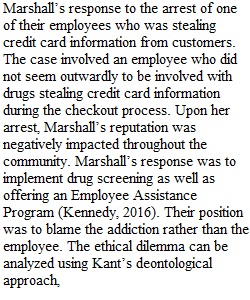


Q Week 4 Ethical Dilemma Project: Ethical Dilemma and Application of Ethical Theory Last week you selected and described the case for your Ethical Dilemma Project. This week you are to identify the ethical dilemma(s) in the case you chose and apply ethical theory to analyze and resolve the problem(s) you identified in the case. Note: You are being graded on your demonstration of reasoning, critical thinking, and analytical abilities in applying what you are learning about ethical issues in the profes-sions. You will be using your text and outside sources of information, so please provide in-text citations and references using APA formatting. Please use the template labeled Week 4: Ethical Dilemma Project: Ethical Dilemma and Application of Ethical Theory (Links to an external site.) to complete this assignment. The completed assignment is due at the end of Week 4 and is worth 100 points. Please see the rubric for the grading criteria. Ethical Dilemma Make an initial estimation of the ethical dilemma present, that is, what the core issues are in the case. What is the main ethical conflict or problem? Describe the key ethical dilemma in one or two sentences or in a "should" question. Application of Ethical Theory Use at least three ethical theories (Kant's deontological theory, John Stuart Mill's teleo-logical theory/utilitarianism/consequentialism, Aristotle's virtue-based approach, John Rawl's theory of justice, or your own theory) to analyze and resolve the problem. How would each ethicist explain the ethical problem and resolve it? This section should be at least two pages and headings should be used to identify each of the three theories. Cite all sources using APA documentation. Choose one of the available choices and write a two-page Word document (.docx) out-lining the rationale for your answer. You should include principles that you have learned so far in this course. Be sure to provide adequate information to support your answer. Remember to use the template provided and submit your assignment. Rubric Week 4: Project Rubric Week 4: Project Rubric Criteria Ratings Pts This criterion is linked to a Learning OutcomeEthical Dilemma Using the case selected in Week 3, identifies the key ethical dilemma in one or two sentences or in a "should" question 10 to >0.0 pts Full Marks 0 pts No Marks 10 pts This criterion is linked to a Learning OutcomeApplication of Ethical Theory Uses three ethical theories to analyze the ethical dilemma and to re-solve the problem according to each ethical theory; includes principles learned from the ethicists, includes details and acknowledges sources 60 to >0.0 pts Full Marks 0 pts No Marks 60 pts This criterion is linked to a Learning OutcomeMy Choice Explains the theory you chose to solve the problem and your reasons for your choice; refers to specific ethical principles from the ethicist and provides detailed support 20 to >0.0 pts Full Marks 0 pts No Marks 20 pts This criterion is linked to a Learning OutcomeWriting Factors Uses the APA template provided; documents sources with in-text cita-tions and a references page; reflects clear organization and correct grammar and mechanics; meets length requirement 10 to >0.0 pts Full Marks 0 pts No Marks 10 pts Total Points: 100
View Related Questions